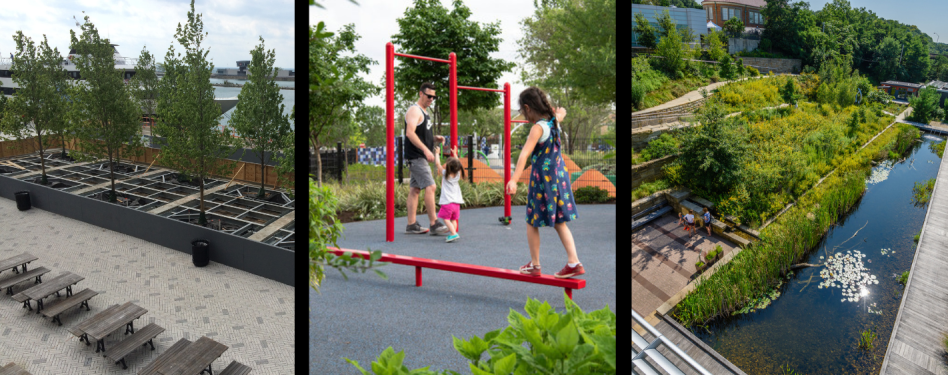
How does SITES work for a project within a larger campus? Can SITES apply to a master plan? My project will take years to build out, so can I apply SITES to a multi-phased project? Yes, yes and yes. Read on for the breadth of projects SITES can help with.
From a small vegetated rooftop in Tokyo, Japan, an infill park in downtown San Francisco, a cemetery in Pennsylvania, a “pierscape” in Hong Kong to a 177 acre residential development in Brazil, SITES supports the creation of high-performance landscapes everywhere.
At GBCI, we strongly encourage you to reach out (via sites@gbci.org) if you have any questions or concerns about your project. We regularly meet with teams before and after they register to understand their projects’ context, schedule and future plans. Our goal is to assist you and your team toward a project that is as sustainable, resilient and healthy as it can be for its users and the community. Below are a few examples of the types of SITES applications.
A project in its planning phase
In 2020, GBCI launched SITES Precertification as a means to recognize projects in their planning phase (rather than after construction is completed). Projects use precertification to ensure that SITES principles, strategies and benchmarks are embedded in the planning process early on. The formal recognition by GBCI can also help with funding, approval from the community members, or may help with permitting in some localities. SITES Precertification also gives project teams, like the one for Silver Bow Creek Conservation Area, a Superfund redevelopment project in Montana, insight on how to elevate sustainability practices and how they might perform in a full certification review.
A project within a large campus
SITES can provide a comprehensive tool and method to verify that new construction projects within a larger campus contribute to a university’s or corporate campus' overarching sustainability goals. For example, the University of Texas at Austin redeveloped 16 acres of its campus to build the new Dell Medical School and its teaching hospital, Dell Seton Medical Center. The Sasaki-designed grounds restored an urban creek and native landscape as the key unifying element weaving through the new development. The SITES certified Dell Medical District unites people, buildings and the environment— offering multiple benefits such as flood control, reduced outdoor water use, improved habitat value, outdoor opportunities for mental respite and social engagement. Check in with us to see how a campus approach can ease your SITES certification.

SITES certified Dell Medical District
A multi-phased project
Projects that have a complicated or long construction timeline may pursue SITES in phases. One option is to register each phase of the project as its own SITES project. GBCI offers discounts if three or more phases register. Documentation can be streamlined in some cases. For example, certain credits in Section 1: Site Context and Section 2: Pre-Design Assessment + Planning may be submitted once for all phases. Additionally, this approach may apply to Sections 7 and 8 of the rating system, if construction, operations and maintenance strategies and plans are consistent for every phase. However, if site context and programming are very unique to other phases, this may require additional documentation.
A LEED project
If you would like your project to benefit from certifying to both SITES and LEED, you can take advantage of the synergies between SITES and LEED BD+C or LEED ND. For example, Orange Mall Expansion is the first project certified under the SITES v2 Rating System at Arizona State University. The team was able to seek synergies between a LEED project and the SITES project, allowing it to gain upwards of 40 points in SITES from certain credits earned already in the LEED BD+C v4 Rating System. Plus a team only needs to document this once!
Located in the core of ASU’s Tempe Campus, the SITES project replaced a former section of roadway and cul-de-sac with a new pedestrian mall and multi-use plaza for programmed events and informal social gatherings by students, faculty and staff. Developed in concert with the adjacent LEED Platinum and emerging Net Zero Student Pavilion, the project utilizes low impact development (LID) techniques to create an integrated sustainable design solution for both building and site.
Also, A project that receives SITES Gold certification automatically earns the credits in the Sustainable Sites category in LEED BD+C v4.
A large project
Size is no limit for SITES Certification! Sites over 100 acres not already pursuing the phased-in approach should contact the SITES Team at GBCI to discuss their project. Certain credits may need to be adjusted to consider the scale such as Credit 1.7: Connect to multi-modal transit networks, Credit 6.5: Support physical activity and Credit 9.1: Promote sustainability awareness and education, and additional fees may apply.
